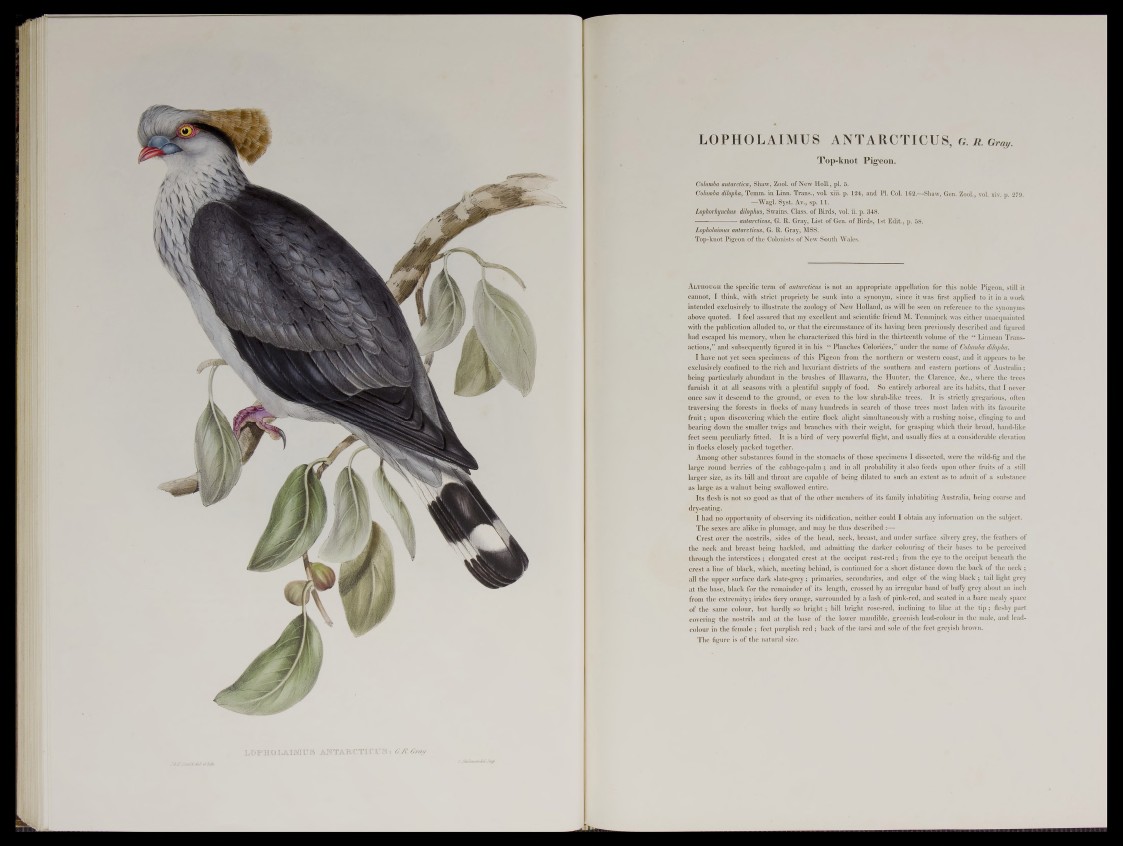
LOP HO LA1MUS ANTARCTICUS, g . r . Gray.
Top-knot Pigeon,
Columba antarctica, Shaw, Zool. of New Holl., pi. 5.
Cohmba dilopha, Ternm. jpJ ^ ^ T^ans.. vol. xiii. p. 124, and PI. Gqk 162.—Shaw, Gen. Zool., voL xiv. p. 279.
—Wagl. Sys|.;'
Lophorhynckus dilophus, Swains. Class, of Birds,
------------------antarcticus., ^ ^ ^ s Gravl8 List of Gen. of Birds, 1st Edit..!p;j
Lopholaimus antarcticus, G. R. Gray, MSS.
Top-knot ’Pigepnof ^e/C6lbniswor^ ^ ^ ^ ^ M Wales.
Although th e ^W ffi^ teEm vofc g ^ ggCCT(^. is^HOt' 'an appropriate appellation for this noble Pigeon, still it
cannot, § thinly with*. strict proprilety h i since it was first applied to it in a work
intended exclusively to illustrate the zoology of New Holland, as will be seen on reference to the synonyms
above quoted. I feel assured that my excellent and «eiem^fic friend M. Temmjnck was either unacquainted
with the publication alluded to, or that the circumstance of its having been previously described and figured
had escaped his memory, when h© c h a r a c t e r i z e d ! t h i r t e e n t h volume of the “ Linnean Transactions,”
and subsequently figured it in»hf^*^Plajnches. ^ lo r ie e s /^ ^fflhr^the name of Columba dilopha.
I. have not yet seen specimens of this 'Bigep^ftonJ,^tbe•-^^t^^^(^, western coast, and it appears to be
exclusively confined to the rich andfIfixuBadfe (^triots^o^^Ko southern* and eastern portions of Australia;
being particularly abundant in 'the*bru,shes^ (M^ni^a^ra,^;the;^’^ jn |h r,i the. Clarence, &c., where the trees
furnish it at all seasons with a plentiful supply offood. ■ So entirely arboreal are its habits, that I never
orice saw it descend to the ground, or even to the Jo^p ^ n p lliKe^trees. It is, strictly gregarious, often
traversing thjgf forests in flocks of many hundreds in search o f those trees most laden with its favourite
B g r upon discovering which the entire flock alight simultaneously with a rushig^noisei clinging to and
hearing down the smaller twigs and branches with their weight, for grasping which their broad, hand-like
feet seem peculiarly fitted. It is a bird of very powerful flight, anal usu ^ p flie s at a considerable elevation
ihiflpckJclQsely packed together.
Among other s ^ ^ a c e s ifo u n d in the stomachs of those specimens I dissected, were the wild-fig and the
large round berries of the cabbage-palm; and in all ^^dhability|tAlso fee(^|gmq;bther fruits of a still
larger size, as itsrh i^ tliroat are capable of being dilated to such a ^ ^ t,e n f ’a# to adinit of a substance
as large as a walnut being swallowed entire, •ƒ'
Its flesh is not so^^^'g^^tihgbjt p f th e ^ g e r members of its family inhabiting Australia^ being coarse and
dry-eating.
I had no opportunity of observing its .nidification, neither could I obtain subject.
The sexes are alike in plumage, and mg^bci^hus* described:—a w
Crest over the nostrils, sides of the -head, neck, breast, and under surface silvery grey,, the feathers of
the neck and breast being hackled, a p ^ ^ ^ ^ i n g the darker of-their bases tMbp perceived
through the in t^ sfe e s ;, elongated crest at the occiput rust-red; from the eye to the occiput beneath the
crest a line of black, which, meeting behind,. i§ cohtmued for a shqrt d |s j^ # ^ »w n the back of the neck ;
all the upper surface dark slate^pey | primaries, secondaries, and edge of thewing black; tail light grey
at the base, black for the remainder of its length, crossed by an irregular band of huffy gray about an inch
from the extremity; irides fiery orange, surrounded by a lash of pink-red, and s e ^ ® n , a bare mealy space
of the same colour, but bardJyso brig h t; bill bright rose-red, unc]bninMto lilac at theAiip fleshy part
covering the nostrils and a t the base of the lower mandible, greenish lead-colour in the male, and lead-
colour in the female; feet purplish red ; back o f the tarsi and sole of the feet greyish‘h | o ^ ; _
The figure is of tjxe n3J^ |k sh $ * '